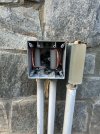jnissen
Getting the hang of it
Thanks @jnissen.
The above 800 ft spool you linked to would provide just the right amount of cable for my two runs.
The info you provided some time back, and the encouragement, got me ready to terminate my own cable,
Then, I got cold feet and started looking for pre-terminated cable!
In a preliminary/casual search for some odd reason multi-mode pre-terminated cable appears to be pricier than single mode.
OM3 in terms of capacity will be plenty for me.
I just have to figure out how to get it in.
BTW, the cable you linked to does not appear to be a burial grade cable ... you OK with that?
If it works, I'd go with it because the conduit gives flexibility.
I recently got some pull tape that is marked in foot-increments, and am going to get a measurement to validate my estimate of actual length.
Thinking of getting somebody to terminate the cable, much as I like to do stuff myself.
Yes I’m ok with that since I used a PVC conduit for the fiber to run inside. I would use direct bury if not using a conduit. Armored would provide more protection but does require careful consideration of the ground.
I’ve actually used both ground rated as well as the riser rated. I liked using the conduit and riser fiber better. Allows you to replace the fiber in the future if needed. You can use plain black poly pipe as conduit if you’re contemplating costs.
Like you I was afraid to try terminating my own fiber. After I’ve done a few I feel comfortable with that and wouldn’t hesitate to go this route. The snap on end kits are cheap enough and a few simple tools give you great results.
Sent from my iPad using Tapatalk









